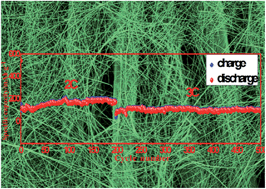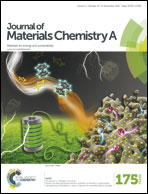Ultra-long Na2Ti3O7 nanowires@carbon cloth as a binder-free flexible electrode with a large capacity and long lifetime for sodium-ion batteries†
Abstract
Flexible energy-storage devices have attracted much attention in recent years due to their promising application in wearable sensors, smart electronics, and implantable medical devices. Novel electrode architectures and new systems are considered to be the best choices to improve the electrochemical performance. Here, ultra-long Na2Ti3O7 nanowires (L-NTO NWs) with a length of more than 100 μm and a width of 100–200 nm were grown on a carbon cloth (CC) substrate by a one-pot hydrothermal method. The porous structure formed by the interwoven nanowires enables sufficient electrode/electrolyte interactions and fast electron transportation. Meanwhile, the unique 3D architecture can maximize the active interface between the nanowires and electrolyte, enabling a long lifetime, large capacity, and a high coulombic efficiency. As a binder-free flexible electrode for sodium-ion batteries, this novel L-NTO NW@CC anode electrode demonstrates a high specific capacity of 170.3 mA h g−1 (close to 100% of the theoretical capacity), excellent cyclability with a capacity retention of over 96% after 200 cycles at 2C, and—following cycling at a current density of 3C—a discharge capacity of 100.6 mA h g−1 after 300 cycles. This work is expected to provide a feasible and effective approach to design flexible electrodes with a long lifetime and large capacity for sodium-ion batteries.


 Please wait while we load your content...
Please wait while we load your content...